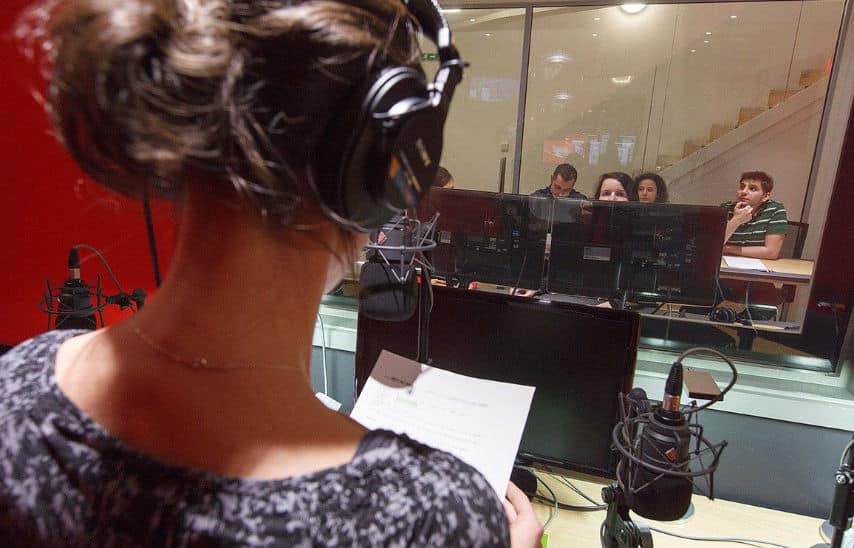Voices are a powerful medium—they tell stories, evoke emotions, and forge connections. In today’s rapidly advancing technological landscape, the debate of AI voice vs human audio has become increasingly relevant. As AI-generated voices grow more lifelike, businesses and creatives face a critical decision: embrace the innovation of AI or rely on the timeless artistry of human voice actors.
This article explores their differences, strengths, and practical applications, offering guidance on choosing the right solution for your project
Table of Contents
ToggleThe Essential Differences Between AI and Human Voice Production
AI Voices: Efficiency and Scalability for Functional Tasks
AI-generated voices are created using advanced algorithms trained on massive datasets of speech patterns. This technology provides fast, consistent, and scalable voice solutions, particularly for functional applications.
AI shines in projects requiring consistency and speed.
For instance, global companies producing multilingual eLearning modules can deploy AI voices to deliver the same content in English, French, and Mandarin with uniform quality. Similarly, AI is widely used in interactive voice response (IVR) systems, ensuring professional and consistent customer service.
A key benefit of AI lies in its scalability. In localisation projects, AI can produce voiceovers in multiple languages or dialects within tight deadlines, which would otherwise require extensive human resources. Programmatic audio advertising also leverages AI, generating high volumes of personalised audio ads quickly and affordably.
However, AI’s limitations become apparent in storytelling-driven projects. It struggles to convey complex emotions, such as transitioning from excitement to sorrow, making it less suitable for audiobooks or animated films. This lack of emotional depth sets clear boundaries for its use in creative content.
Understanding Human Speech Characteristics
Human Voices: The Emotional and Authentic Edge
Human voices bring a richness and authenticity that technology has yet to replicate. A professional voice actor does more than read a script—they interpret it, using tone, pacing, and emotion to bring words to life.
Consider the narration of a nature documentary. Beyond simply providing information, the voice actor adjusts their tone to evoke wonder during scenes of untouched wilderness and concern when discussing environmental challenges. This emotional adaptability draws the audience into the story, creating a lasting impact.
Human voices are also deeply rooted in cultural sensitivity. A voice actor delivering a script for a British audience will naturally incorporate colloquialisms and regional nuances, ensuring the content resonates. AI, while improving, still struggles with these subtleties, particularly in multilingual projects where cultural context is vital.
For emotionally charged projects like audiobooks, charity campaigns, or animated series, human voices remain indispensable. Whether it’s Morgan Freeman’s soothing authority in documentaries or the vibrant performances in Pixar films, the emotional depth of human voices forges connections that transcend words.
Cost-Effectiveness Guide: Balancing Budget and Impact
Budget considerations often dictate the choice between AI and human voices. While AI offers clear cost advantages, the decision ultimately depends on your project’s goals.
AI voices excel in repetitive or large-scale tasks. Companies producing hundreds of eLearning videos or automated prompts for IVR systems save significantly by avoiding studio costs and recurring talent fees. AI also adapts quickly to different languages, further reducing costs for multilingual projects.
Human voices, on the other hand, are an investment in quality and emotional resonance. A luxury car brand’s TV ad, for instance, benefits from the confidence and warmth of a human narrator, reinforcing the brand’s premium image. While more expensive upfront, the impact of a well-delivered human performance often outweighs the costs, particularly for branding and storytelling projects.
Hybrid approaches are becoming increasingly popular. A global training program, for example, might use AI for instructional sections and human narrators for motivational or emotionally engaging segments, balancing cost-efficiency with quality.
Can AI Voices Be Edited for Specific Projects?
One of AI’s major strengths lies in its ability to be customised for specific projects. AI-generated voices can be fine-tuned to match tone, pitch, pacing, and even style, making them adaptable to a range of applications.
What Variations in Pitch and Tone Can AI Voices Achieve?
AI technology allows for extensive adjustments in pitch and tone. For instance, an AI voice can be programmed to sound upbeat for promotional content or solemn for a corporate announcement. By tweaking parameters like intonation and pacing, AI can emulate basic emotions such as happiness, excitement, or seriousness.
However, these adjustments often lack the fluidity of human delivery. A cheerful tone might suddenly feel forced, or a solemn pitch may fail to capture the subtleties of sadness. In storytelling contexts, where emotions shift dynamically, AI often struggles to maintain natural transitions, making human voices the superior choice.
Real-world applications of AI pitch and tone adjustments include eLearning modules and customer service chatbots. While effective for these functional tasks, their mechanical quality can detract from projects requiring emotional nuance.
What Are the Quality Considerations for AI Voice Compared to Human Audio?
When comparing AI to human audio, several quality factors come into play. AI excels in clarity and consistency, especially for straightforward scripts. For example, AI is often preferred for system prompts, where consistent pronunciation and tone are crucial.
Human audio, however, offers a richer texture and naturalness that AI cannot yet replicate. Voice actors bring personality and intent to their delivery, ensuring the audio remains engaging, even over extended durations. For instance, in a motivational speech or audiobook, a human narrator’s ability to infuse lines with emotion ensures listeners remain captivated.
AI’s clarity can falter with complex or creative scripts, where monotony or unnatural phrasing can reduce impact. These limitations make human voices the preferred choice for projects demanding authenticity.
How Do AI Voices Handle Pronunciation and Speech Patterns?
AI has made significant progress in mastering pronunciation and speech patterns. Modern AI systems can accurately pronounce words in multiple languages and even mimic regional accents to some degree. For example, AI can handle diverse customer queries in a multilingual call centre with impressive efficiency.
However, challenges remain, particularly with specialised terminology or colloquial expressions. Medical scripts, legal content, and idiomatic phrases often expose AI’s weaknesses, leading to mispronunciations or awkward phrasing. In contrast, human voice actors adapt intuitively to these challenges, ensuring every line sounds natural and well-articulated.
Post-production editing can mitigate AI’s shortcomings. Human oversight is crucial for correcting errors, refining phrasing, and ensuring the final product meets professional standards. This collaborative approach helps bridge the gap between AI efficiency and human quality.
Common Errors in AI-Generated Audio: A Technical Analysis
Despite its advancements, AI-generated audio still has notable limitations. Common issues include robotic phrasing, tonal inconsistencies, and pronunciation errors. These flaws can disrupt listener engagement and reduce the professionalism of a project.
Human oversight plays a vital role in addressing these shortcomings. By involving voice directors or editors, AI-generated audio can be fine-tuned to align with the project’s goals.
For example, in a technical training module, a human editor might refine AI’s pronunciation of specialised terms, ensuring clarity and credibility.
This collaborative model combines the best of both worlds: the efficiency of AI and the artistry of human refinement.
Future Trends in AI Voice Technology
The future of AI voice technology is brimming with potential. Developers are working on improving emotional range, creating voices capable of expressing nuanced emotions and subtle tonal shifts. Enhanced adaptability is also on the horizon, with AI voices becoming more responsive to context.
Custom AI voices tailored to specific brand identities are already emerging. For example, a travel app could develop a signature AI voice that embodies its brand’s friendly and approachable personality. Real-time interaction is another exciting frontier, particularly in gaming and virtual reality, where dynamic, AI-driven dialogue could create immersive experiences.
Ethical considerations will play a growing role in this evolution. Transparency about AI use and respect for intellectual property rights will be critical as the technology becomes more sophisticated. Ultimately, AI and human voices are likely to coexist, complementing each other to meet diverse audio needs.
Key Takeaways: Finding the Perfect Balance
The choice between AI voices and human audio depends on your project’s specific needs. AI excels in scalability, speed, and cost-effectiveness, making it ideal for functional tasks. Human voices offer unmatched emotional depth and authenticity, making them indispensable for creative and storytelling-driven content.
By understanding these strengths and limitations, you can create compelling, high-quality audio that resonates with your audience. At GoLocalise, we pride ourselves on the unmatched artistry of our professional voice actors, delivering tailored solutions that resonate with every project.






















